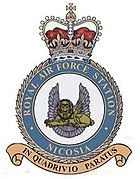RAF Nicosia
Coordinates: 35°9′1.9″N 33°16′49.2″E / 35.150528°N 33.280333°E
RAF Nicosia | |||||||||||||||
|---|---|---|---|---|---|---|---|---|---|---|---|---|---|---|---|
 "In Quadrivio Paratus"[1] | |||||||||||||||
| Summary | |||||||||||||||
| Airport type | Military (and formerly: joint Military & Civil) | ||||||||||||||
| Owner | Ministry of Defence | ||||||||||||||
| Operator | formerly: Royal Air Force, now: United Nations | ||||||||||||||
| Serves | Nicosia | ||||||||||||||
| Location | Lefkosia, Cyprus | ||||||||||||||
| Runways | |||||||||||||||
| |||||||||||||||
Royal Air Force Station Nicosia or RAF Nicosia was a Royal Air Force (RAF) station on the island of Cyprus, built in the 1930s. The station served as Headquarters Royal Air Force Cyprus from 8 June to 29 July 1941.
The original principal airport for Cyprus, Nicosia International Airport, was built within the site of the RAF station. Both civil and military aviation on the island operated from the site, although the RAF disestablished the station in 1966.
The 1974 Turkish invasion of Cyprus led to the cessation of commercial operations from the airport, although the site is still owned by the British Ministry of Defence,[2] but is controlled by the United Nations Peacekeeping Force in Cyprus and used as a base by United Nations peace-keeping patrol helicopters.
Station history[edit]
Source: Britain's Small Wars[3]
- No. 6 Squadron RAF first used the airfield on 3 October 1946 with the Supermarine Spitfire LF.9 before re-equipping with the Hawker Tempest F.6 in December of that year and moving to RAF Shallufa on 5 September 1947. The squadron returned on 5 April 1951 with the de Havilland Vampire FB 5 before leaving to RAF Deversoir on 22 May 1951 however the unit soon returned on 31 May 1952 with the Vampire FB 9 before leaving on 11 July 1952 moving to RAF Habbaniya. The unit returned on 28 August 1954 with the de Havilland Venom FB 1 before moving again to Habbaniya on 5 October 1954, on 7 November 1955 the unit returned for the final time with the Venom FB 4. The squadron moved to Habbaniya on 12 December 1955.[4]
- No. 8 Squadron RAF – operating Auster AOP6 (from Jul. 1950); de Haviland Vampire (from Jul. 1953)
- No. 29 Squadron RAF – operating Gloster Javelin (from Mar. 1963)
- No. 32 Squadron RAF – operating English Electric Canberra B2
- No. 33 Squadron RAF – operating Gloster Javelin FAW7
- No. 39 Squadron RAF – operating Gloster Meteor NF13
- No. 43 Squadron RAF – operating Hawker Hunter FGA 9 (from Jun. 1961)
- No. 46 Squadron RAF – operating unknown aircraft.[5]
- No. 70 Squadron RAF – operating Vickers Valetta C1, Handley Page Hastings
- No. 73 Squadron RAF – operating de Havilland Venom FB4
- No. 74 Squadron RAF – operating Spitfire V, later Mk IX (from Sep. 1943)
- No. 80 Squadron RAF – operating Hurricane MkI (from Jun. 1941)
- No. 84 Squadron RAF – operating Vickers Valetta C1
- No. 103 Squadron RAF – operating Bristol Sycamore HC1
- No. 114 Squadron RAF – operating Vickers Valetta C1, de Havilland Chipmunk T10
- No. 127 Squadron RAF – operating unknown aircraft.[5]
- No. 162 Squadron RAF – operating unknown aircraft.[5]
- No. 185 Squadron RAF – operating ???
- No. 202 Squadron RAF – operating Hawker Hunter F6
- No. 203 Squadron RAF – operating unknown aircraft.[5]
- No. 208 Squadron RAF – operating Spitfire FR XVIII
- No. 213 Squadron RAF – operating Tempest VI
- No. 230 Squadron RAF – operating Scottish Aviation Pioneer CC1
- No. 234 Squadron RAF – operating ???
- No. 243 Squadron RAF – operating unknown aircraft.[5]
- No. 249 Squadron RAF – operating de Havilland Venom FB1
- No. 250 Squadron RAF – operating unknown aircraft.[5]
- No. 256 Squadron RAF – operating ???
- No. 261 Squadron RAF – operating unknown aircraft.[5]
- No. 272 Squadron RAF – operating unknown aircraft.[5]
- No. 284 Squadron RAF – operating Bristol Sycamore HR14
- No. 294 Squadron RAF – operating unknown aircraft.[5]
- No. 451 Squadron RAAF – operating unknown aircraft.[5]
- No. 459 Squadron RAAF – operating unknown aircraft.[5]
- No. 603 Squadron RAF – operating ???
- No. 680 Squadron RAF – operating unknown aircraft.[5]
- No. 14 Squadron RNZAF – operating de Haviland Vampire (1952–55)
RAF Regiments[edit]
- No. 2 Squadron RAF Regiment
- No. 21 Squadron RAF Regiment
- No. 26 Squadron RAF Regiment
- No. 27 Squadron RAF Regiment
- No. 29 Squadron RAF Regiment
- No. 34 Squadron RAF Regiment
- No. 37 Squadron RAF Regiment
Current use[edit]
The site is now the currently largely disused Nicosia International Airport.
See also[edit]
- List of aircraft of the Royal Air Force
- List of former Royal Air Force stations
- List of Royal Air Force aircraft squadrons
- Royal Air Force station
References[edit]
Citations[edit]
- ^ Pine, L G (1983). A Dictionary of mottoes. London: Routledge & Kegan Paul. p. 110. ISBN 0-7100-9339-X.
- ^ House of Commons Hansard Written Answers for 19 Jan 2005 (pt 6)
- ^ "British units serving in Cyprus 1955–1959". Britain's Small Wars. Archived from the original on 12 October 2011. Retrieved 22 January 2008.
- ^ Jefford 1988, p. 26.
- ^ a b c d e f g h i j k l Jefford 1988, p. 169.
Bibliography[edit]
- Jefford, C.G. RAF Squadrons, a Comprehensive Record of the Movement and Equipment of all RAF Squadrons and their Antecedents since 1912. Shrewsbury, Shropshire, UK: Airlife Publishing, 1988. ISBN 1-84037-141-2.
External links[edit]
![]() Media related to Royal Air Force at Wikimedia Commons
Media related to Royal Air Force at Wikimedia Commons


No comments:
Post a Comment